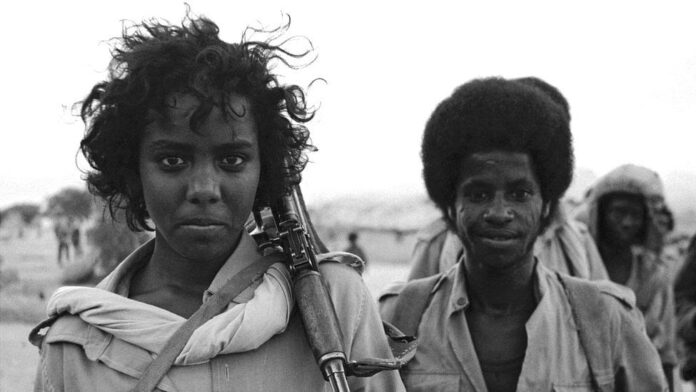
Eritrea is officially marking 30 years of independence from Ethiopia. Former BBC Tigrinya editor Samuel Ghebhrehiwet was a soldier who fought for independence. He writes about his experiences on the battlefield, and how hopes were dashed as Eritrea became a repressive one-party state.
During our 30-year armed struggle for independence, we lived with war every hour of every day.
We got used to pain and sacrifice. Many of us were wounded two or three times during fighting. We were quickly patched up and marched into more battles.
I still wonder how we managed to cover ground from Qarora – the northern tip of Eritrea – to Dumeira – the southern tip – sleeping in trenches and climbing every mountain and valley. I was among the fortunate ones. About 65,000 of our fighters died in combat.
I joined the liberation army as a 16-year-old in 1982 after hearing tales about Ethiopian aggression and jealous of the glamorous image of the freedom fighters with their long hair, shorts and AK47s.
I received a few months of training in the Arag valley. We learned how to attack and retreat, how to camouflage ourselves, and how to use weapons – including grenades and RPGs.
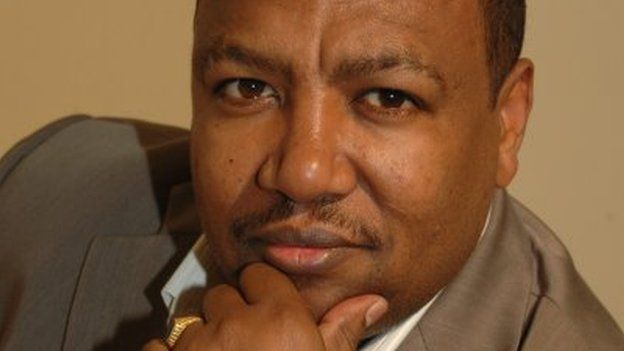
Our training was good. It was backed up by political education, including how we would establish a democratic government.
I was involved in numerous battles, culminating with the liberation of the port city of Massawa in the Fenqel operation of February 1990. That operation was decisive. It put a stranglehold on the Ethiopian military’s movements, and ultimately forced them out of Eritrea.
We fought intense battles for 72 hours to capture this strategic city, and we then defended it for more than a year with 100km-long trenches. In these battles, I suffered shrapnel wounds to my head and hand. I was treated in hospital. After I was discharged I returned to the battlefield.
Towards the end of the 1990s I was sent to join the cultural group to boost the morale of our army with revolutionary songs and dramas. In 1991, we were on Dahlak Island, near Massawa, when we heard the biggest news of our lives – we had finally achieved our independence.
Days of celebration
Filled with joy, we travelled by boat to Massawa. We were then loaded on to lorries to go to the capital, Asmara – a journey that took about three hours. We crossed the Ethiopian military’s southern checkpoint. It was unmanned, the Ethiopian soldiers had abandoned it.
There was a dreamlike atmosphere in Asmara. People in the city dropped everything to welcome the independence fighters. They broke into impromptu “guayla” (traditional music and dance) on the streets of the capital, as well as other towns and villages.
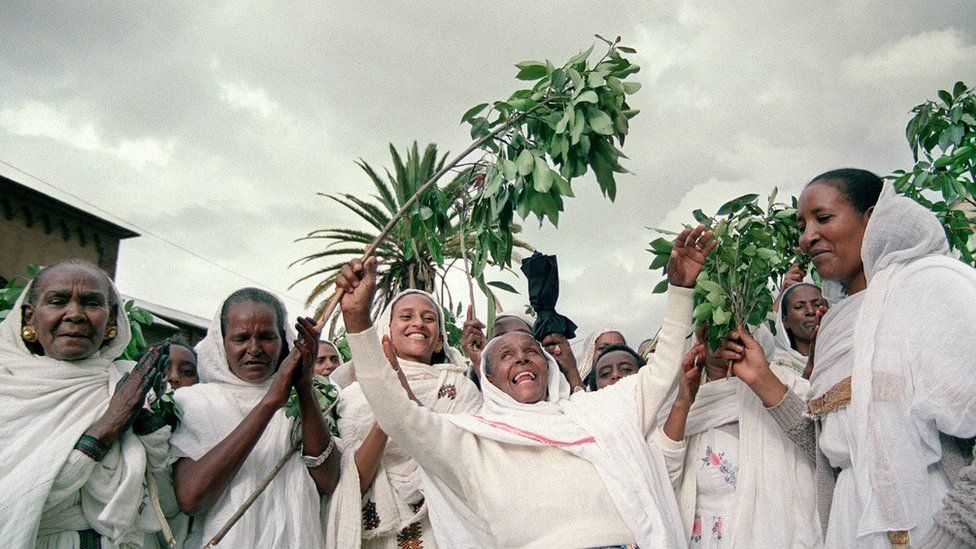
Before that momentous day, the people of Asmara were totally besieged. The airport was constantly being bombed, there was a strict curfew. Then on 24 May everything changed.
Mothers abandoned earthen pots on their “fernello” (coal stoves); forgot the fire in the “mogogo” (ovens) and walked out on their coffee rituals to join the welcome party.
People carrying palm leaves, which are often used in celebrations, invaded the streets – every palm tree was stripped. The young ones climbed onto the tanks that rolled in and waved their palm leaves.
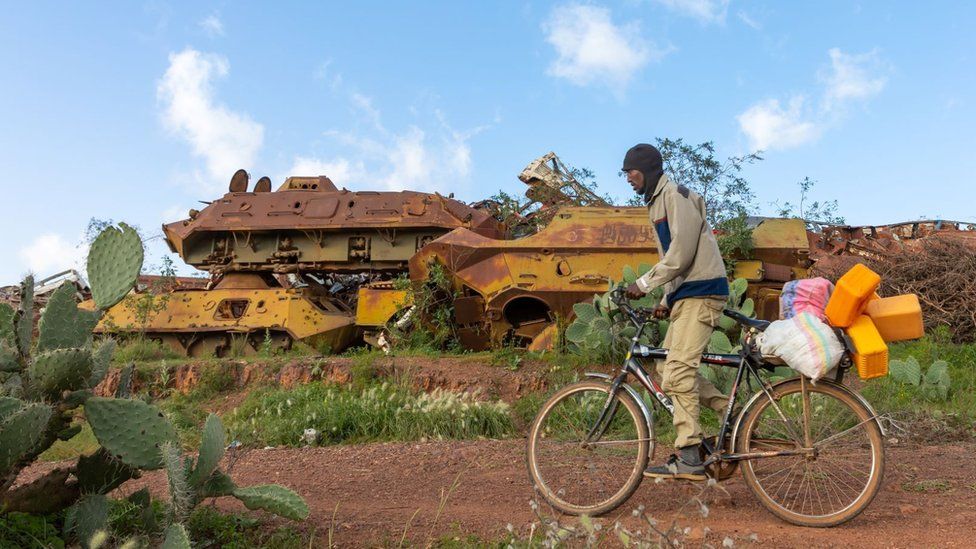
The celebrations went on for days and nights.
There was much anxiety amid the euphoria as there were many parents out in the streets with picture frames in their hands. They were asking the arriving fighters about the whereabouts of their children.
“Did they make it back? Did they die?”
I remember Seyum Tsehaye, the designated fighter photographer, taking pictures of the momentous occasion as his unit rolled in.
I also remember two members of our unit – Gedle and Abayey – coming face-to-face with their family members while they were still on the back of the lorry. The joy, the screams, the tears.
Gedle’s father was so overjoyed he beat his chest with his palm branch.
“I found my son! I found my son!” was all that came out of his mouth as he ran in front of our lorry. Abayey, the female fighter who was in the driver’s compartment, recognised her mother-in-law and tried to jump off the lorry, almost injuring herself.
We were accompanied by cheering crowds all the way to Albergo Ciao – a hotel in the city.
Later, we were told by our commanders that we could go out and look for our family members – those of us who had relatives in town. It was not easy to find them in a couple of hours, after years away. But we did.
We all hoped that Eritrea was going to flourish and we would live happily ever after.
Leaders enjoying themselves
Unfortunately, it did not take long for our hopes to be dashed. We gave everything we had – our youth and lives – to achieve independence. We had dreams.
Many of us wanted to go to our families, resume our studies, take up civilian jobs, form a family and do well in our communities. We were very surprised that we were not even allowed to leave the army.

Eritrea – a history of struggle:

- A former Italian colony which later formed loose federation with Ethiopia
- Ethiopian Emperor Haile Selassie dissolved Eritrean parliament, seized Eritrea in 1962
- Eritrean separatists fought guerrilla war until 1991, when they captured capital Asmara, voting for independence in 1993
- May 1998 border dispute with Ethiopia led to two-year war costing 100,000 lives
- Ethiopia’s new Prime Minister Abiy Ahmed and Eritrean President Isaias Afwerki end hostilities in July 2018
We were told that the country had nothing. “All we have is the armaments we brought in with us,” our commanders-turned-leaders told us.
After such a long and arduous life in the battlefields, we, the ex-fighters, were once again asked to tighten our belts. We were instructed to continue our work unpaid. We were only given food. This lasted for about two years, and then we started getting some money.
The fighters who functioned as one family unit during the revolutionary years were dismayed when they became aware of the leaders’ behaviour – many were simply having a good time as soon as the country was liberated.
Some top leaders were seen in bars, drinking excessively – enjoying themselves while the regular fighters struggled. The chain of command and the regular meetings were neglected.
The ordinary “tegadelti” (freedom fighters) waited patiently for their conditions to change but nothing happened.
War with the neighbours
In 1993, on the eve of the second anniversary of Eritrea’s independence, the ex-fighters protested and asked their leaders to listen to their grievances. They forced their leaders to call a meeting in Asmara’s main stadium.
“We understand your problems; it is a common problem; we will resolve the situation together,” was the answer given.
As soon as the protest was over, the leaders secretly detained the protest leaders – one by one over a few days. Soon after, they were sentenced to jail terms ranging from one to 15 years.
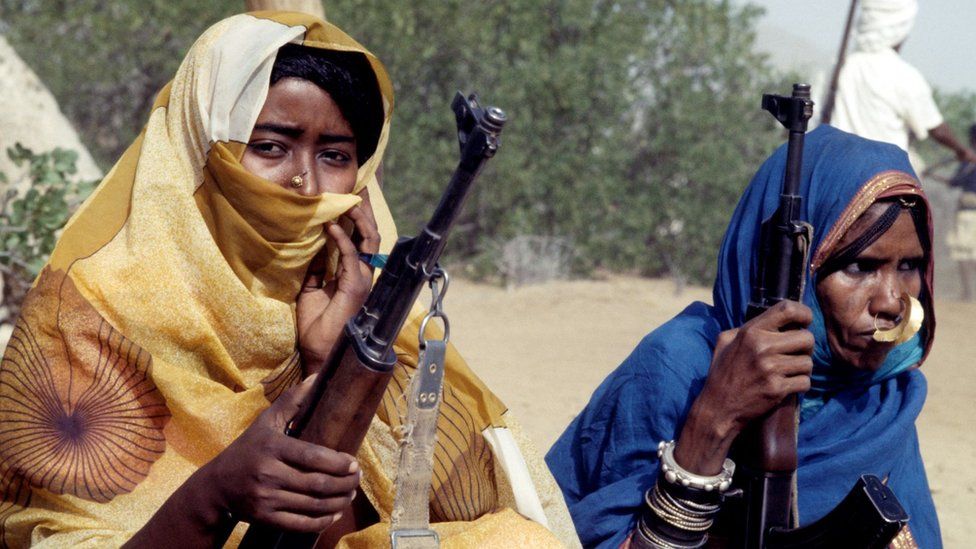
They paid a heavy price for highlighting their plight – they ended up becoming victims. Many said that the regime was following a path to dictatorship; others called for patience, saying the constitution that Eritreans had been promised would be drafted and the country would head towards democracy.
None of this has happened. Eritrea remains a one-party state, having never held an election to choose the president or government.
In the meantime, Eritrea has found itself at war with all its neighbours at some point – Yemen in 1995, Sudan in 1996, Ethiopia from 1998 to 2000 and Djibouti in 2008. The country lost tens of thousands more young lives.
Now, Eritrean troops are involved in the fifth conflict since independence. They are in Ethiopia’s Tigray region, fighting alongside Ethiopian troops against the Tigray People’s Liberation Front (TPLF).
The TPLF was in power in Ethiopia when Eritrea’s independence was formalised in a referendum in 1993, and during the 1998-2000 border war between two nations.
In the immediate aftermath of independence, I joined a ruling party-supported cultural troupe, hoping to honour freedom fighters and help build the country. I wrote plays and songs, and took part in performances. One of Eritrea’s most famous musicians, Helen Milles, sang one of my songs: Massawa – Where are your Precious Children?
Later, I worked as a journalist for a government-owned newspaper until I went into exile.
Change is inevitable
The little political space that existed came to an end after the Ethiopia-Eritrea border war.
The government became gripped by a siege mentality, as it feared destabilisation from Ethiopia and accountability from its own citizens over a conflict that many believed could have been avoided through dialogue.
In September 2001, the government ordered a crackdown. Eleven top officials and many middle-ranking cadres who supported the idea of reform were arrested. Later they were thrown into prisons, never to be heard of again.
Eleven journalists who were publishing the grievances, letters and calls of the reformist group were also detained; their newspapers banned. Among them was my good friend and colleague Seyum, the photographer who captured the momentous time of independence.
None of them were brought to an independent court and their whereabouts remain unknown.
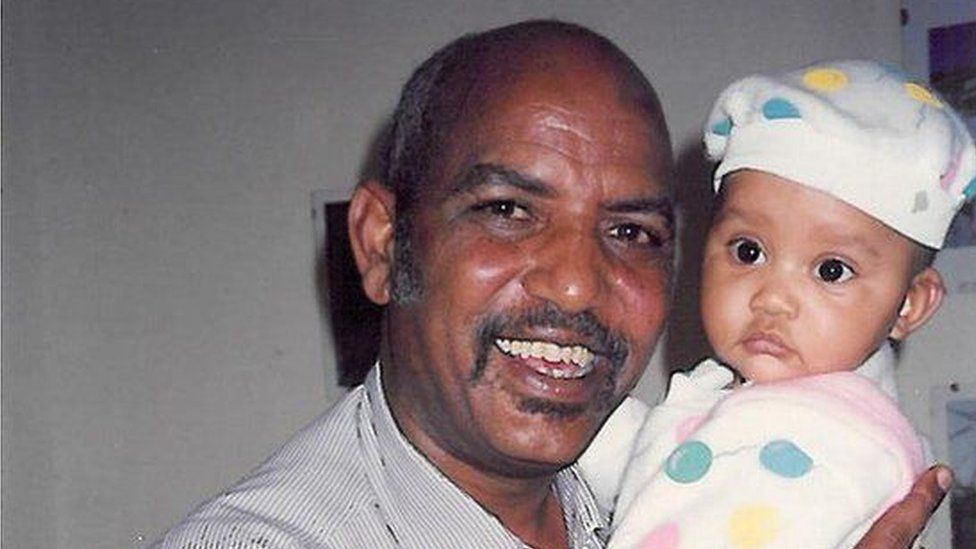
Eritrea remains a one-party state that has not held a national election since independence. There is no free press or independent civil society groups. All international NGOs and local civic organisations are banned.
Official statistics show that healthcare and education have improved since independence but is it difficult to believe them. With limited job prospects and the prospect of years of compulsory unpaid military service, many young people continue to leave the country, seeking asylum in other African states or Europe.
But many of us have not given up hope. We believe change is inevitable and Eritrea will realise the promises made by its martyrs.
SOURCE: BBC




